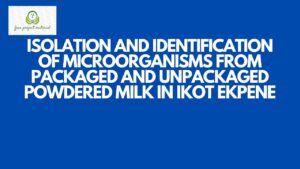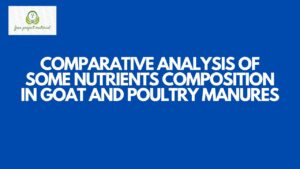ABSTRACT
The study on comparative heavy metal analysis of waterleaf (Talinum triangulare) cultivated with inorganic and organic fertilizer was carried out using standard analytical methods. The result of the study revealed that waterleaf samples cultivated with inorganic fertilizer had higher concentration of Pb, Cd, and Cr that were above the that of sample cultivated with organic fertilizer, control and the WHO permissible limit. However, sample TOF and the control had heavy metal concentration that were below the WHO permissible limit. This therefore implies that the consumption of the waterleaf cultivated in this fertilizer could result in health complications. Thus, it is recommended that Cultivation of waterleaf with inorganic fertilizer should be avoided since waterleaf has a high capacity to absorbed heavy metals in it.
TABLE OF CONTENTS
Title Page – – – – – – – – – i
Declaration – – – – – – – – – ii
Certification – – – – – – – – – iii
Dedication – – – – – – – – – iv
Acknowledgement – – – – – – – – v
Abstract – – – – – – – – – vi
Table of Contents – – – – – – – – vii
CHAPTER ONE
1.0 INTRODUCTION
1.1 Background of the Study – – – – – – 1
1.2 Aim and Objectives of the Study – – – – 5
1.3 Scope and Limitation of the Study – – – – 6
1.4 Definitions of Terms – – – – – – 7
CHAPTER TWO
2.0 LITERATURE REVIEW
2.1 Routes of Heavy Metal Exposure – – – – 8
2.2 Classification of Heavy Metal Exposure – – – 9
2.3 Mechanism of Action of Heavy Metals – – – 10
2.4 Heavy metal Poisoning – – – – – – 10
2.5 Selected Heavy Metals and their Effects – – – 12
2.5.1 Cadmium – – – – – – – – 12
2.5.2 Arsenic – – – – – – – – 13
2.5.3 Lead – – – – – – – – – 14
2.5.4 Chromium – – – – – – – – 15
2.6 Talinum triangulare – – – – – 16
2.6.1 Nutritional and Health Benefits of Talinum triangulare – 17
CHAPTER THREE
3.0 MATERIALS AND METHODS
3.1 Materials – – – – – – – – 19
3.2 Methods – – – – – – – – 19
3.2.1 Sample Collection and Experimental Design – – – 19
3.2.2 Sample Preparation – – – – – – 20
3.2.3 Sample Digestion – – – – – – – 20
3.2.4 Filtration of Sample – – – – – – 21
3.3 Determination of Heavy Metal – – – – – 21
CHAPTER FOUR
4.0 RESULTS AND DISCUSSION
4.1 Results – – – – – – – – 23
4.2 Discussion – – – – – – – – 24
CHAPTER FIVE
5.0 CONCLUSION AND RECOMMENDATIONS
5.1 Conclusion – – – – – – – – 28
5.2 Recommendations – – – – – – – 29
References
CHAPTER ONE
1.0 INTRODUCTION
1.1 Background of the Study
Heavy metals are generally referred to as those metals which possess a specific density of more than 5 g/cm3 and adversely affect the environment and living organisms (Järup, 2003). They, without doubt, are important constituents for plants and humans, when present only in small amount. Some micronutrient elements may also be toxic to both animals and plants at high concentrations. For instance, copper (Cu), chromium (Cr), fluorine (F), molybdenum (Mo), nickel (Ni), selenium (Se) or zinc (Zn). Other trace elements such as arsenic (As), cadmium (Cd), mercury (Hg) and lead (Pb) are toxic even at small concentrations (Divrikli et al., 2006). Heavy metals, being persistent and non-biodegradable, can neither be removed by normal cropping nor easily leached by rain water (Khadeeja et al., 2013). They might be transported from soil to ground waters or may be taken up by plants, including agricultural crops. For this reason, the knowledge of metal plant interactions is also important for the safety of the environment (Divrikli et al., 2006).
There has been increasing interest in determining heavy metal levels in public food supplied. However, their concentration in bio-available form is not necessarily proportional to the total concentration of the metal (Opaluwa et al., 2012; Nwachukwu et al., 2010).
The quality of ecosystem becomes altered, when heavy metals find their way, somehow, into it through human and natural activities. These activities are one of the most pressing concerns of urbanization in developing countries like Nigeria, which result in the problem of solid, liquid and toxic waste management. Such waste may be toxic or radioactive (Onibokun and Kumuyi, 2001; UNDP, 2006). Such waste management problems include heaps of uncontrolled garbage, roadsides littered with refuse, streams blocked with rubbish, prevalence of automobile workshops and service stations, inappropriately disposed toxic waste and disposal sites that constitute a health hazard to residential areas (Adewole and Uchegbu, 2005; Rotich et al., 2006).
Vegetables constitute important part of the human diet, since they contain carbohydrates, proteins, fats, as well as vitamins, minerals and bioactive compounds (Mepha et al., 2007). In recent years, consumers demand for better green leafy vegetables is rapidly increasing among the urban community. This is due to increased awareness on their nutritive and herbal values (Uwah et al., 2009). These vegetables are harvested at all stages of growth and fed either as processed, semi-processed or fresh to man while they are usually offered fresh to livestock. The perceptions of what is regarded as a better quality are however subjective. Some consumers consider colour and size as characteristics of good quality leafy vegetables. However, physical characteristics of leafy vegetables alone cannot guarantee safety from heavy metal contamination (Aja et al., 2007).
Leafy vegetables have greater potential of accumulating heavy metals in their edible parts than grain or fruit crops because they are largely xylem-loaded and heavy metals are generally greatly mobile in the xylem. Contamination of human food chain by heavy metals is not directly affected by the plants total uptake but rather by the concentration in their parts that are directly consumed. According to Lee et al., (2002) sensitivity of animals to heavy metals toxicity depends on heavy metal accumulation rate in the edible parts of the plants and intake rate, amongst other factors.
Several studies have shown that the presence of toxic heavy metals in biological systems can cause oxidative stress which promotes the formation of reactive oxygen species that damage cells (Buchannan et al., 2000). Plants scavenge and dispose of these reactive molecules by use of antioxidant and defense system present in several sub-cellular components. The major antioxidant species in plant are ascorbate, reduced glutathione, ∝ -tocophenol and carotenoids; polyamines and flavonoids also may provide some protection from free radical injury (Foyer et al., 2000). The medical significance of oxidative stress has become increasingly recognized to the point that it is now considered to be a component of virtually every disease process including aging, coronary heart diseases, inflammation stroke, diabetes mellitus and cancer. The beneficial health effects of vegetables have been attributed in part, to antioxidant phytochemical compounds present in them and their ability to chelate some heavy metals and prevent their absorption from ingested food (Graziani et al., 2005).
In Nigeria, inorganic and organic fertilizers are widely used and have been implicated as the chief source of heavy metal pollution of agricultural fields (Mapanda et al., 2005). The production of leafy vegetables using mechanized agricultural techniques is well practiced in Nigeria but little is known on the contamination of leafy vegetables with heavy metals. Thus, this study examined the comparative analysis of arsenic, cadmium and lead in Talinum triangulare cultivated with organic manure and fertilizer.
1.2 Aim and Objectives of the Study
The aim of this study is to determine the comparative analysis of arsenic, cadmium and lead in Talinum triangulare cultivated with organic manure and fertilizer.
Objectives of the Study
The objectives of this study are;
- To cultivate Talinum triangulare with organic manure and fertilizer
- To determine the arsenic, cadmium and lead content of Talinum triangulare cultivated with organic manure
- To determine the arsenic, cadmium and lead content of Talinum triangulare cultivated with fertilizer.
- To compare the arsenic, cadmium and lead contents of Talinum triangulare cultivated with organic manure and fertilizer.
1.3 Scope and Limitation of the Study
This study focused on the determination of arsenic, cadmium and lead contents of Talinum triangulare that is cultivated on salt enriched with organic manure and fertilizer.
1.4 Definition of Terms
Organic Manure: Organic Manure, also known as natural manure, is a type of fertilizer that is derived from natural sources such as animal waste, plant matter, and other organic materials.
Fertilizer: a chemical or natural substance added to soil or land to increase its fertility
Talinum triangulare: Talinum triangulare is a leafy vegetable found in open waste places with rich top soil.
Heavy Metal: A metal of relatively high density, or of high relative atomic weight.
Bio-accumulation: Bioaccumulation is the gradual accumulation of substances, such as pesticides or other chemicals, in an organism.

